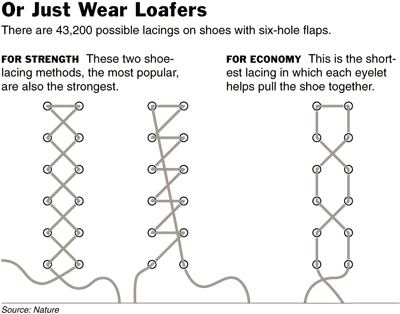
|
By KENNETH CHANG
From the "New York Times" December 10, 2002
By KENNETH CHANG From the "New York Times" - December 10, 2002 How many ways are there to lace a shoe? Unlike most everyone else in the world, Dr. Burkard Polster gave this question a lot of thought, often at night. "Instead of counting sheep, I might count lacings," said Dr. Polster, a mathematician at Monash University in Victoria, Australia. "To relax from mathematics, you do more mathematics."
The shoe-tying world is dominated by two lacings. The most popular is a simple crisscross, each end of the shoelace pulled through the next eyelet on the opposite flap. The second common way is to pass one end of the lace from the last eyelet across to the top eyelet on the opposite flap and then zigzag the other end in an N pattern through the eyelets. A multitude of trendy shoe fashion possibilities remains to be discovered, Dr. Polster said. A shoe with two rows of six eyelets offers 43,200 different paths for a shoelace to pass through every eyelet, even with the added condition that each eyelet must contribute to the essential purpose of pulling the two halves of the shoe together. (More precisely, this condition says the shoelace is not allowed to pass in a straight line through three consecutive eyelets on the same flap; otherwise, the middle of the three eyelets does not actively help close the shoe.) Most of 43,200 lacings are unaesthetic tangles, and Dr. Polster started wondering which ones are the strongest and which require the least amount of shoelace. A shoelace essentially acts like a pulley system, and through simple calculations, Dr. Polster showed that the two common lacings are the strongest, although not equally so. When the eyelets are narrowly spaced and the flaps relatively far apart, the crisscross lacing is strongest. The X's in this lacing are short and squat, so the tension in the shoelace is exerted mostly in the horizontal direction that brings the flaps together. If the eyelets are farther apart, then the zigzagging N pattern provides the tightest tie. The shortest lacing is one Dr. Polster calls the bow tie, because the shape outline of the lacing pattern passingly resembles an untied bow tie. The shoelace passes from one eyelet to its neighbor on the same flap and then diagonally across to the other flap. "I've only seen it twice in the shoe store," Dr. Polster said. Dr. Rosalind Cotter, editor of Nature's "Brief Communications" section, noted the article was scientifically rigorous and had passed through the same peer review process as other papers in the journal. "It's just a bit of fun," she said. The work was inspired by research in 1999 by a couple of Cambridge University physicists who figured out how many ways there were to knot a necktie (85). Dr. Polster, who has worked on the mathematics of origami and juggling, sought his own fashion problem. When you are looking for everyday activities that can be attacked with mathematics, you just look in the mirror, he said. He found one at his feet. In the Nature paper, Dr. Polster also offered advice for tying shoelace knots that do not unravel 10 steps later. Most people tie their shoes in two steps, essentially layering two half-knots on top of each other (for example, wrapping the left piece of the lace over and around the right one and pulling it through, then wrapping the left piece over and around a loop of the right piece of shoelace and pulling a second loop through). That produces a granny knot, which is unstable. Reversing the orientation of the first half-knot (by passing the left piece of the lace under the right one and pulling it through) produces a knot that will hold much longer.
|
 His mathematical musings made it into
the current issue of the journal Nature.
His mathematical musings made it into
the current issue of the journal Nature.